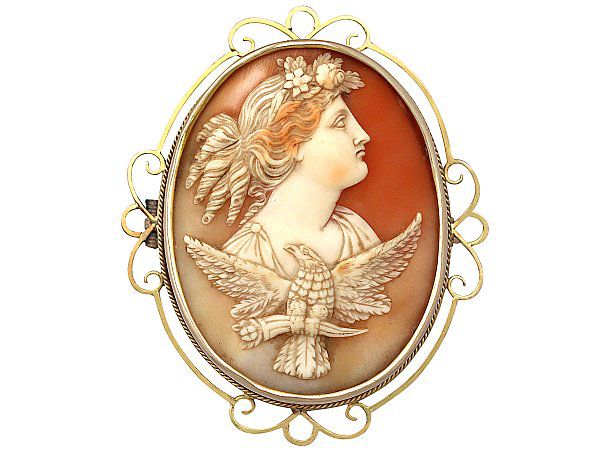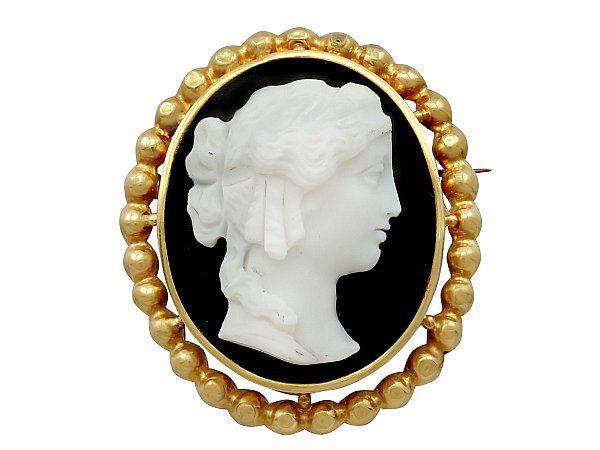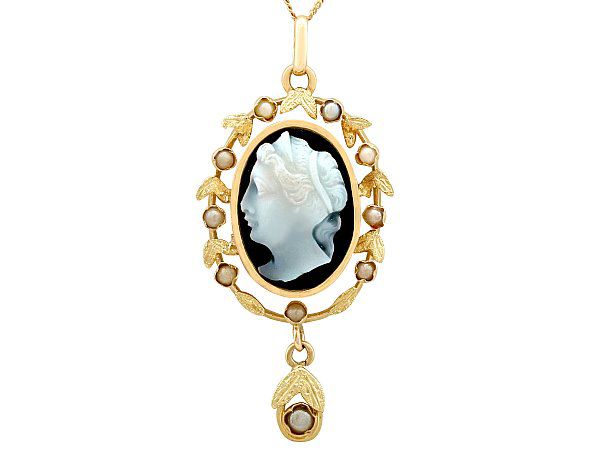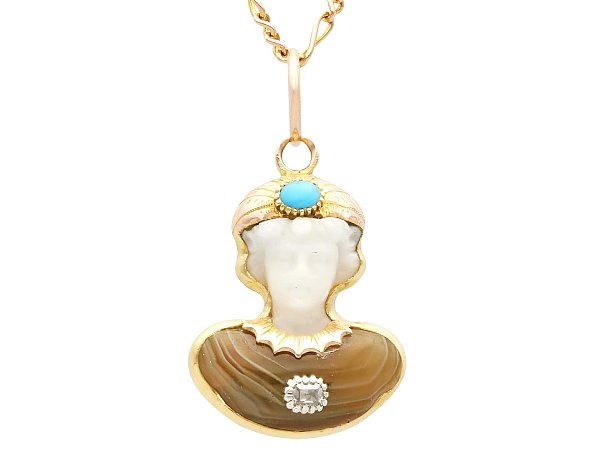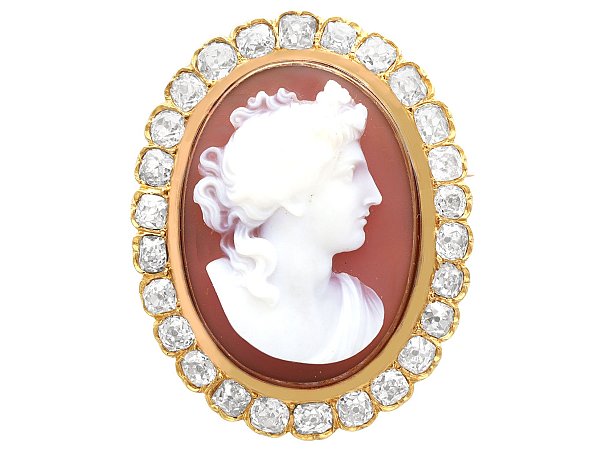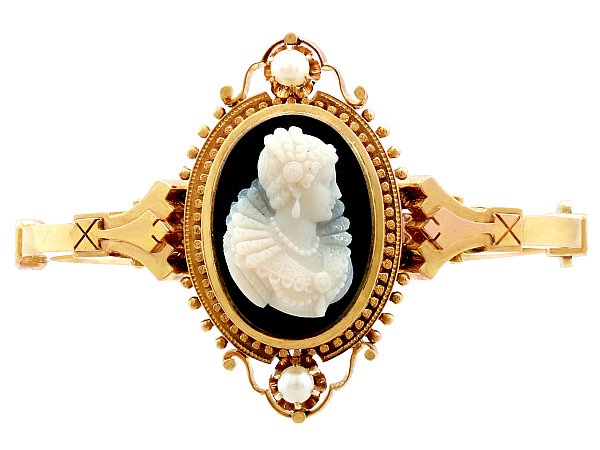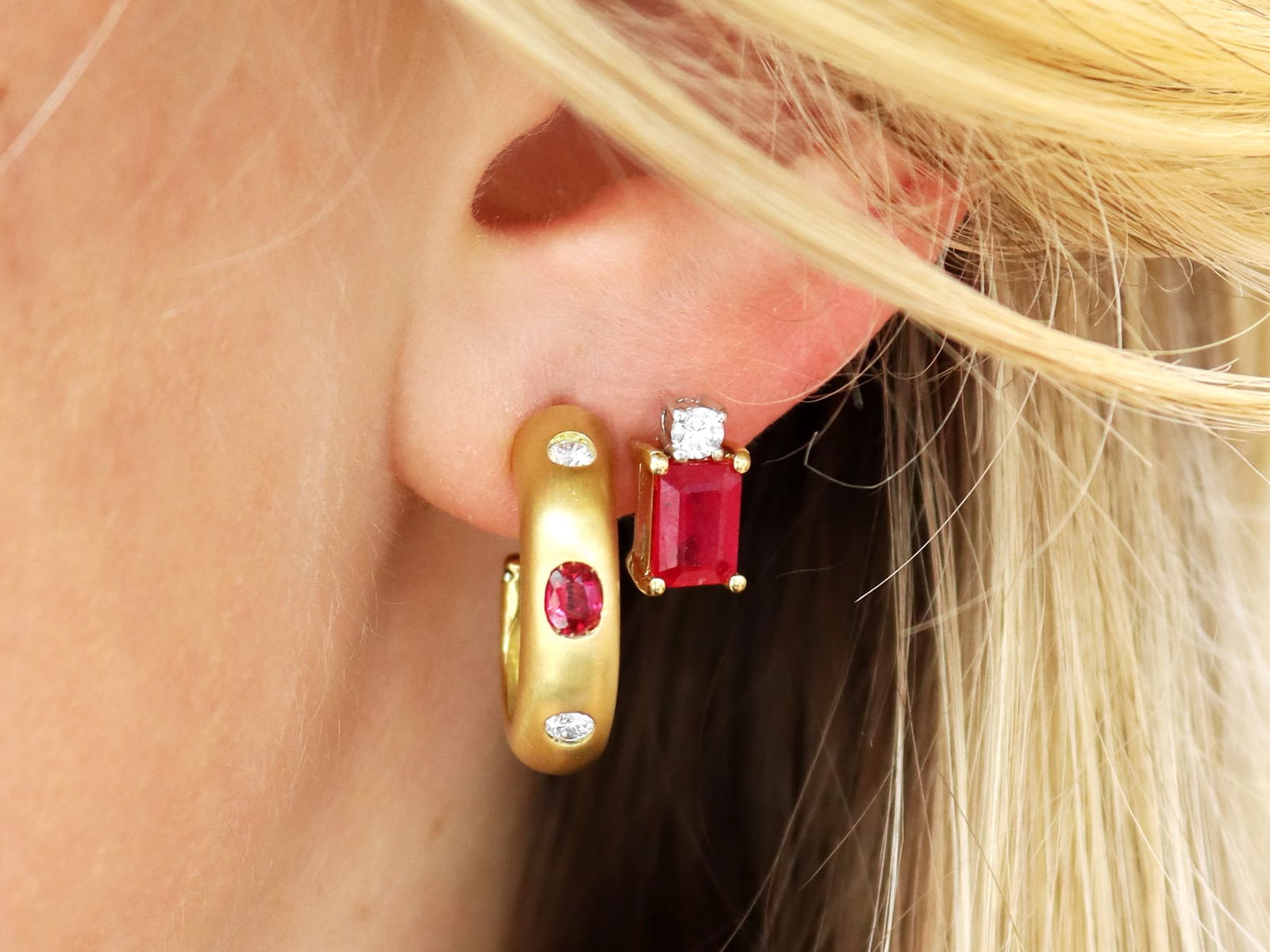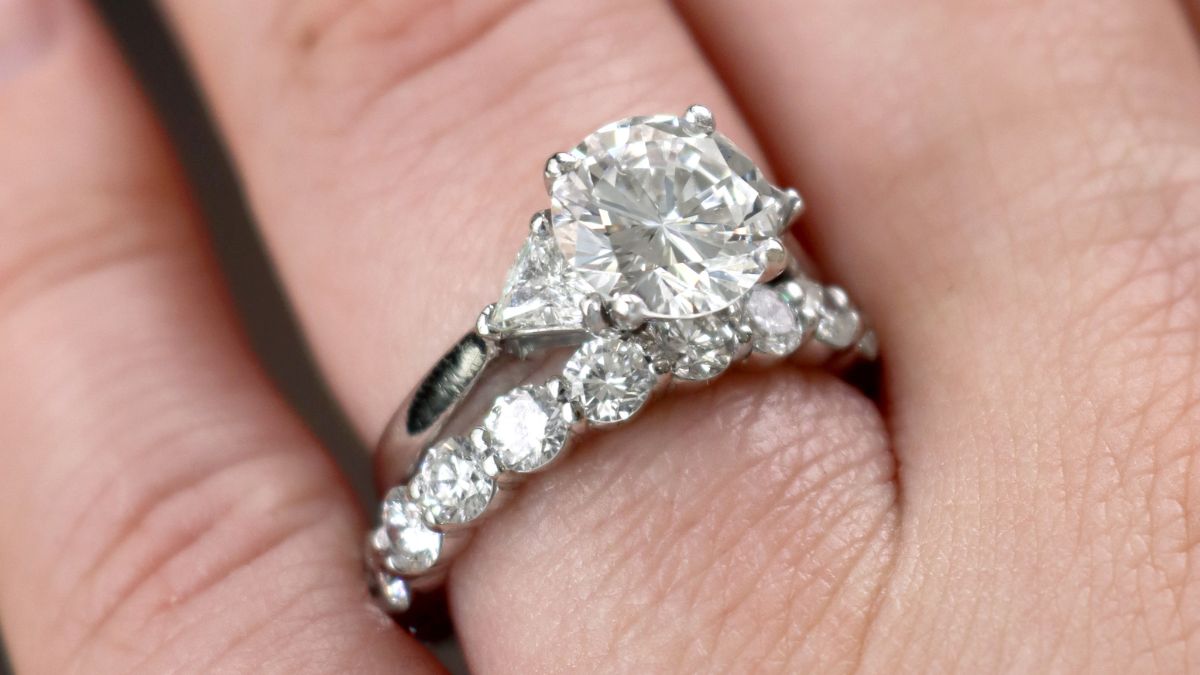Although we mainly associate cameos with the image of a face in profile, ‘cameo’ actually refers to the method of carving rather than the subject. Cameo jewellery history is an interesting one, dating back to 300 BC. The subjects and purpose of cameos may have changed since, but their popularity has remained fairly constant. Cameo brooches are perhaps the most common style seen today, but cameo lockets, bracelets and rings can also be highly impressive collectors’ items.
How Are Cameos Made?
Cameos consist of images carved in relief, against a different coloured background. The material used to craft a cameo can vary, as can the subject. Materials that have been used throughout history to create cameos include:
- Carnelian shell: peachy orange in colour.
- Sardonyx: featuring a dark background with a white foreground, a dark brown marbled interior with a thick outer wall.
- Mother of pearl: Opalescent in colour with hints of blueish grey. Best results are achieved when it is set in silver.
- Agate: A blueish green in colour.
- Other sea shells.
The method of carving cameos takes great skill and craftsmanship. Many artists have dedicated their lives to the craft. To create a cameo, you first must divide the shell (or material of choice) into two parts. One part will be used to make the cameo, and the remaining piece is normally used to make smaller trinkets. Next, the ‘cup’ (the section piece used to create the cameo) is split into two again. This will produce two pieces of shell which are thick and rich in colour.
When you have your ideal section of the material, you must then smooth and round the back of the piece. After this, attach the piece to a wooden stick and face to rough, convex side to the front, ready to begin your carving. Most makers would first choose the sketch their design onto the shell, and then commence the carving.
Historically, most cameo carvers carved by hand. They would normally use a tool called a bullino, which has been used by Italian carvers for 100s of years. Nowadays, some carvers tend to opt for a small dental drill, which creates a similar effect.
Cameos can take anywhere between a few hours and a few days to complete. Sitting near natural light helps the process greatly, but as for the rest, it is a matter of patience and precision.
What are Cameos Worth?
The worth of a piece of cameo jewellery is innately connected with the quality of the cameo itself. Over time, it’s fairly common for cameos to become worn or cracked, leading to an inevitable loss of value. For the best possible value, a cameo should clearly display its subject, meaning that all of the finer details of its carving are clear and crisp, with a definite definition distinguishing the colour of the main material and the colour of the carved section itself.
Cameos depicting more than a simple portrait are also more expensive. Some larger cameo pieces display an entire scene with multiple figures and even plants. These cameos – in good condition – are worth more than the standard portrait found in most cameo jewellery. The value of these cameos comes partially for the rarity of the design, and partially for the skill involved in clearly carving the scene.
The other main factor that would contribute to the worth of a cameo is the material used to make it.
Most cameos available today are made from carved shell, hardstone, agate, and other materials that are sturdy and strong. You can, however, find some cameos made from more precious materials. Any cameos made from these materials are sure to be more valuable.
Where Did Cameo Jewellery Originate?
As is the case with a lot of brilliant and beautiful things – jewellery and otherwise – we can give credit to the Ancient Egyptians for the cameo brooch. In 15,000 B.C, Egyptians used to carve gemstones and rocks to show figures of all kinds. In the time since then, different materials have been used and more and more refined tools have made it possible to create detailed portraits, usually depicting figures in an Ancient Greek style.
In their original form, cameos were used to depict important events, and over time – as widespread literacy eventually evolved across the globe – cameos became more and more about portrait art rather than telling a story. Even though cameo jewellery moved on from being a storytelling device, it was still very common for cameos to depict well-known mythical and religious characters.
When Did Cameo Jewellery Become Popular?
Although the original cameo jewellery pieces were created in Ancient Egypt, their popularity soared in the Victorian era. The archaeological discoveries that occurred during the Victorian period led to an enormously increased interest in ancient cultures.
The discovery of Ancient Greek artifacts like cameo jewellery pieces ignited a widespread passion for the style. Victorian jewellers were able to make a range of jewellery pieces featuring the cameo portraiture. Despite the fact that original ancient cameos would have likely been painted bright colours, Victorians made their cameos white to reflect the ancient discoveries. Over centuries of weather and wear, most Ancient Greek cameos lost all colouring, appearing to be the bone-white colour we associate with the ancient civilisation today.
Prominent public figures enjoyed cameo jewellery, influencing the public interest in the style. Cameo jewellery was associated with class and status, and owning a piece of this type of jewellery was a statement. The style fell out of fashion around the turn of the 20th century. The advent of the Art Deco style saw people looking to the future. Cameo designs were considered old-fashioned at this time. In the last century, however, the cameo style has lingered. It found new popularity in the 2010s as people looked to past eras for inspiration.
Why do People Wear Cameo Jewellery?
In ancient cultures, cameos were often used as seals. The impression made by a cameo being pressed into hot sealing wax allowed people to secure their letters or stamp their mark on documents. For this reason, cameo jewellery has long been associated with a level of status. Only important people needed to stamp their seal, and therefore cameos were for important people.
The portrait style cameos worn in the Victorian period were fashion statements above all else. They served as symbols of status in their own way because of their popularity with influential members of society. Today, people wear cameo jewellery simply to appreciate the beauty of the designs. Some people have cameos commissioned to give to a loved one when celebrating special occasions.
History of the Cameo
Cameos can be traced back to 300 BC Alexandria, Egypt. During these ancient times, scenes would be carved in to rocks to express various things. Important events and figures were documented in this way, as were religious statements and moral teachings.
During the Greek and Roman eras cameos most frequently featured images of gods and goddesses. Inspiration also came from mythological heroes and biblical events.
In the Hellenistic period cameos took on yet another role. At this point they started being worn as jewellery and were used as signals. For example, if a young girl was wearing a cameo which depicted a dancing eros this could signal a seductive invitation.
Although today we are more familiar with cameos being worn by women, up until the Elizabethan period they were more commonly worn by men. This is because they were associated with military attire; often being found on helmets and sword handles. During the reign of Elizabeth I however, they found their way into general fashion, with women wearing them as a sign of status.
Upon the excavation of Pompeii in 1748, the tourism industry boomed and trips the ancient site became very popular. Many tourists chose to bring back souvenirs from their trip in the form of a cameo crafted in lava or shell.
It wasn’t until the 19th Century that cameos which featured a face in profile became popular. This may seem strange as it is easily the most prominent form of cameos today. These profile cameos were most often carved in hardstone or agate.
Famous Cameo Lovers Through History
Cameos have long been a status symbol, whether in brooch, ring, or necklace form. Therefore it is fitting that many famous historical figures had a particular love of them.
- Pope Paul II loved cameos and other jewels so much that some believe it eventually killed him. This sounds extreme, but the cameo rings which he loved wearing are thought to have kept his hands at a dangerously low temperature, leading to a chill and eventual death!
- Napoleon was another cameo enthusiast. He loved cameo jewellery so much that he even wore a cameo to his wedding. He also founded a school dedicated to the craft, making sure students were equipped to learn and practice his beloved art.
- Historical trend setter Queen Victoria owned cameo jewellery and contributed to their popularity during the Victorian era. Sea shell (particularly carnelian shell) cameos were made particularly sought after.
Cameos remain popular today, largely due to the antique nostalgia and aesthetic they present. Our own cameo jewellery displays expert craftsmanship from the Victorian era. Complete with finely carved details and often precious gemstones, it’s easy to see why this style has endured through millennia.


